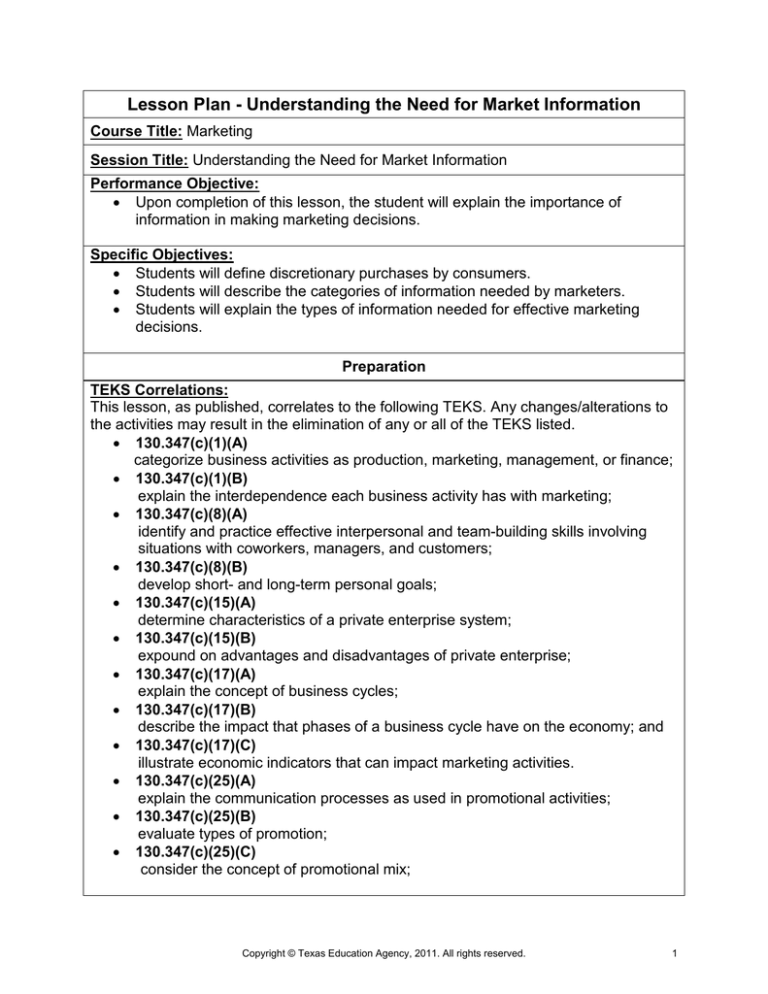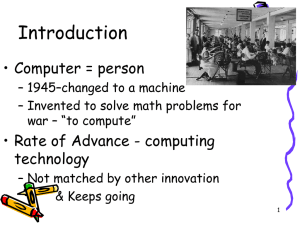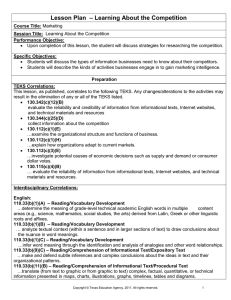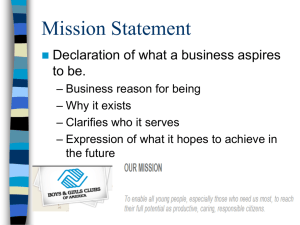Lesson Plan - Understanding the Need for Market Information
advertisement

Lesson Plan - Understanding the Need for Market Information Course Title: Marketing Session Title: Understanding the Need for Market Information Performance Objective: • Upon completion of this lesson, the student will explain the importance of information in making marketing decisions. Specific Objectives: • Students will define discretionary purchases by consumers. • Students will describe the categories of information needed by marketers. • Students will explain the types of information needed for effective marketing decisions. Preparation TEKS Correlations: This lesson, as published, correlates to the following TEKS. Any changes/alterations to the activities may result in the elimination of any or all of the TEKS listed. • 130.347(c)(1)(A) categorize business activities as production, marketing, management, or finance; • 130.347(c)(1)(B) explain the interdependence each business activity has with marketing; • 130.347(c)(8)(A) identify and practice effective interpersonal and team-building skills involving situations with coworkers, managers, and customers; • 130.347(c)(8)(B) develop short- and long-term personal goals; • 130.347(c)(15)(A) determine characteristics of a private enterprise system; • 130.347(c)(15)(B) expound on advantages and disadvantages of private enterprise; • 130.347(c)(17)(A) explain the concept of business cycles; • 130.347(c)(17)(B) describe the impact that phases of a business cycle have on the economy; and • 130.347(c)(17)(C) illustrate economic indicators that can impact marketing activities. • 130.347(c)(25)(A) explain the communication processes as used in promotional activities; • 130.347(c)(25)(B) evaluate types of promotion; • 130.347(c)(25)(C) consider the concept of promotional mix; Copyright © Texas Education Agency, 2011. All rights reserved. 1 • • • • • • • • • • 112(c)(1)(E) …examine the organizational structure and functions of business. 130.112(c)(1)(G) …describe factors that affect the environment. 130.112(c)(1)(H) …explain how organizations adapt to current markets 130.112(c)(3)(A) …compare and contrast the types of economic systems, including traditional, centrally planned, market and mixed economies 130.112(c)(3)(B) …identify business cycles 130.112(c)(3)(C) …summarize the characteristics of the private enterprise system. 130.112(c)(3)(E) …investigate potential causes of economic decisions such as supply and demand or consumer dollar votes. 130.112(c)(6)(A) …explain the importance of different marketing strategies for goods versus services 130.112(c)(8)(B) …discuss motivational theories that impact buying behavior such as Maslow’s Hierarchy of Needs 130.114(c)(1)(A) …explain the strategic role of information systems and information communication technology within an organization Interdisciplinary Correlations: English: 110.33(b)(1)(A) – Reading/Vocabulary Development …determine the meaning of grade-level technical academic English words in multiple content areas (e.g., science, mathematics, social studies, the arts) derived from Latin, Greek or other linguistic roots and affixes. 110.33(b)(1)(B) – Reading/Vocabulary Development … analyze textual context (within a sentence and in larger sections of text) to draw conclusions about the nuance in word meanings. 110.33(b)(1)(C) – Reading/Vocabulary Development …infer word meaning through the identification and analysis of analogies and other word relationships. 110.33(b)(9)(C) – Reading/Comprehension of Informational Text/Expository Text …make and defend subtle inferences and complex conclusions about the ideas in text and their organizational patterns. 110.33(b)(11)(B) – Reading/Comprehension of Informational Text/Procedural Text …translate (from text to graphic or from graphic to text) complex, factual, quantitative, or technical information presented in maps, charts, illustrations, graphs, timelines, Copyright © Texas Education Agency, 2011. All rights reserved. 2 tables and diagrams. 110.33(b)(12)(A) – Reading/Media Literacy …evaluate how messages presented in media reflect social and cultural views in ways different from traditional texts. 110.33(b)(12)(B) – Reading/Media Literacy …evaluate the interactions of different techniques (e.g., layout, pictures, typeface in print media, images, text, sound in electronic journalism) used in multi-layered media. 110.33(b)(12)(C) – Reading/Media Literacy …evaluate the objectivity of coverage of the same event in various types of media. 110.33(b)(12)(D) – Reading/Media Literacy …evaluate changes in formality and tone across various media for different audiences and purposes. Economics 113.34 (c)(12)(A) Compare global trade patterns at different periods of time and develop hypotheses to explain changes that have occurred in world trade and the implications of these changes. Accommodations for Learning Differences: For ED, ESL, LD, Special Ed, at Risk, 504, etc. allow the following: 1. Allow students less than best responses to vocabulary and assignment sheets. 2. Allow students more errors on research and PowerPoint presentations. 3. Allow students more time on internet research. Teacher Preparation: References: 1. Marketing, Third Edition, James L. Burrow, Southwestern Cengage, Learning 2. Marketing Essentials, McGraw Hill 3. USA Today and local newspapers Instructional Aids: 1. Understanding the Need for Marketing Information PowerPoint presentation 2. Independent Practice Assignment #1 Customer Survey for a Restaurant or Automobile Dealership 3. Customer Survey for a Restaurant or Automobile Dealership Rubric 4. Independent Practice Assignment #2 Marketing to the Generations Part Five 5. Marketing to the Generations Rubric 6. Internet Materials Needed: 1. Construction paper 2. Scissors and glue 3. Poster board Copyright © Texas Education Agency, 2011. All rights reserved. 3 4. Newspapers Equipment Needed: 1. Computers for students to complete projects. 2. Projector for PowerPoint presentation. Learner Preparation: 1. Ask students to describe how their family’s needs have changed as the children in the household grew older. Ask students how values and purchases change for an aging population. 2. Ask students to research the Gallup Corporation. What is the mission/purpose of this company? How do businesses use market research? 3. “Not all consumers even in the same age group are created alike.” Ask students to explain what this statement means. Lesson Plan Introduction (LSI Quadrant I): 1. Survey the class to determine how many students have a job. Then ask those students with jobs if they are satisfied with their purchase choices. Define discretionary income and good/bad strategies used by consumers when spending discretionary income. 2. Survey the class to determine if any students desire to be politicians. Then explain how political campaigns monitor success through research polls conducted by organizations like The Gallup Corporation. Ask students why an increasing number of businesses are counting on research companies to find out about customer satisfaction with their company. Important Terms for this Lesson: • discretionary purchases-purchases that are not essential/consumers can decide whether or not to purchase theses items Outline Outline (LSI Quadrant II): Instructors can use the PowerPoint presentation, slides, handouts, current events, the Internet, and note pages in conjunction with the following outline. MI Outline I. The Need for Information A. Consumer Differences B. Expanding Choices for Discretionary Purchase C. Competition D. The Global Marketplace . Copyright © Texas Education Agency, 2011. All rights reserved. Notes to Instructor A. Ask students to write a paragraph about what good or service they enjoy buying. They must explain their strategy for making purchases 4 in this category of goods or services. D. Ask students how many of the products they own are imports. How have events like the Olympics influenced the international marketplace? II. Deciding on Information Needs A. Approaches to Planning 1. information from customers 2. information from sales associates 3. information from marketing research B. Categories of Information 1. consumers a. age b. gender c. income d. education e. family size f. occupation g. attitudes h. primary needs i. purchase frequency j. brand preferences k. information needs l. media preferences m. shopping behavior 2. marketing mix a. basic products b. product features c. services d. product packaging e guarantees f. after-sale-customer service g. product price h. credit choices i. discounts j. location and method of sale k. type of distribution used l. promotion and sales methods m. promotional message Copyright © Texas Education Agency, 2011. All rights reserved. A. Survey students to determine how many have been asked to complete a company survey. What is the reason for the survey? Did the student have an incentive for completing the survey? Ask students to describe a situation where they received outstanding customer service and a situation where the service was awful. What was missing in the second experience and how could that company benefit from customer feedback? B. Ask students to define the current economic climate. How has 5 n. promotional media 3. business environment a. type of competition b. competitors’ strengths c. competitors’ strategies d. economic conditions e. government regulations f. new technology g. consumer protection h. ethical issues i. tax policies j. proposed laws k. international markets climate affected their purchasing decisions? Copy and paste Multiple Intelligences Graphic in appropriate place in left column. Verbal Linguistic Logical Mathematical Visual Spatial Musical Rhythmic Bodily Kinesthetic Intrapersonal Interpersonal Naturalist Existentialist Application Guided Practice (LSI Quadrant III): 1. “When people earn more money, they become addicted to spending more money.” What does this statement mean? 2. Ask students to describe what type of after-sale customer service they expect to receive from a new car dealership. 3. Ask students to explain how the global marketplace has affected product choices and prices. Independent Practice (LSI Quadrant III): 1. Independent Practice Assignment #1 - students will use Customer Survey for a Restaurant or Automobile Dealership to design a short customer survey for a restaurant or automobile dealership service center. The survey should include 10 questions with a rating scale of 1-5, 5 being the best rating. Students will present their findings to the class. 2. Independent Practice Assignment # 2 - students will complete Part Five of the “Marketing to Generations” project. Use Marketing to the Generations Rubric as the evaluation tool for this project Summary Copyright © Texas Education Agency, 2011. All rights reserved. 6 Review (LSI Quadrants I and IV): Q: Why must a business pay attention to an individual consumer’s personal needs? A: Every consumer is different and has their own special needs. Each person has different expectations from the business. Q: What is a discretionary purchase? A: This is a purchase beyond basic needs, something that is not necessary for survival Q: How do businesses compete for sales of items with little differences? A: emphasize brand name, availability, and price Q: Why does a business need marketing research when entering a new international market? A: to collect information about the country, consumers, values, and economy Evaluation Informal Assessment (LSI Quadrant III): 1. Instructor will observe students during Independent Practice assignments, class discussion, class participation, and PowerPoint discussions. 2. Instructor will assist individual students as needed. Formal Assessment (LSI Quadrant III, IV): Use Marketing to the Generations Rubric to evaluate the Fifth part of the “Marketing to the Generations” project. The Customer Survey for a Restaurant or Automobile Dealership Project will be evaluated using the Customer Survey for a Restaurant or Automobile Dealership Rubric for completeness and quality of questions. Extension/Enrichment (LSI Quadrant IV): 1. Ask students to create a survey for students to complete about the high school cafeteria. No leading questions can be asked on the survey. Students will conduct the survey to determine how the cafeteria can meet the expectations of its customers. 2. Ask students to research another country to learn about their standard of living, demand for goods and services, and unique cultural trade practices. Prepare a report about doing business in that country. Copyright © Texas Education Agency, 2011. All rights reserved. 7 Independent Practice Assignment #1 Customer Survey for a Restaurant or Automobile Dealership Name_________________________ Dealership: New automobiles and homes are the largest purchases for many individuals. Consumers have many choices when selecting a new car. They pay attention to gas mileage, special interest rates, customer service, and numerous other factors when deciding on the automobile to purchase. The best automobile dealerships have sales associates who follow-up the sale by communicating with the customer to determine the level of satisfaction. Also the best sales associates communicate periodically with customers to make them aware of new models, great price breaks, and special service deals. Assignment: You have just purchased your first new automobile. Create a customer survey for an automobile dealership with 10 non-leading questions that would be easy and quick for customers to complete. This data should be relevant to the customer and the automobile dealer in order for the dealership to maintain excellent customer service. Restaurant: In today’s on-the-go society, a large number of families choose to dine out several times a week and are demanding a good quality dining experience for their family. With the large number of restaurants and fast-food chains, competition for customers is becoming fierce and price competition is giving way to quality service. The best restaurants are now following up with surveys to determine customer satisfaction with their dining experience. Many restaurants use a web site on their sales receipt and will reward the customer for taking a brief survey. This survey enables the restaurant the ability to improve the quality of service. Assignment: Create a customer survey for a restaurant of your choice with a minimum of 10 non-leading questions that would be easy and quick for customers to complete. This data should be relevant to the customer and the restaurant in order for the restaurant to maintain and improve their excellent customer service. Copyright © Texas Education Agency, 2011. All rights reserved. 8 Customer Survey for a Restaurant or Automobile Dealership Rubric Student Name: ________________________________________ 25 20 15 Quality of Survey Questions Excellent 10 non-leading questions At least 8 good non-leading questions 5-7 good non-leading Fewer than 5 questions non-leading questions Rating Scale Appropriate for Survey Questions Rating scale (rubric) appropriate and easy for consumers to use Rating scale (rubric) good but not appropriate for all questions asked Rating scale (rubric) does not match the type of questions asked Survey questions cannot be rated by consumers on a rubric Rating Categories for the Restaurant Categories selected were researched and validated by the actual restaurant Categories selected were researched but not validated by the actual restaurant Categories selected were not researched or validated by the actual restaurant Inappropriate categories to survey Presentation of Information Well-organized, convincing presentation Good presentation that could be enhanced with more information based on the survey results Fair presentation needing much more information about survey questions and results Poor presentation lacking quality information about the survey and results of the survey CATEGORY 10 or less Total Score_________ Maximum Score 100 pts. Copyright © Texas Education Agency, 2011. All rights reserved. 9 Marketing to the Generations Project Name_________________ Goal: To learn about four target markets that have different backgrounds, needs, and spending habits. Part 1: Conduct Internet research for the following four generations: Silent (Mature) Generation, Babyboomers, Generation X, and Generation Y. Print two sheets of information for each group and highlight the main points. Make sure that you locate the most useful marketing information about each group. Part 2: Design a poster with pictures from a magazine or newspaper to represent each generation. Divide the poster into quadrants—one for each generation. Each quadrant should include pictures of people to represent each generation and 20 facts about each generation. Part 3: Prepare 20-bulleted list for each generation. The list should include descriptive characteristics, needs, and buying habits. Part 4: Write four paragraphs to describe five goods/services that each generation will purchase and why. Each paragraph should be at least five sentences and printed. Part 5: Prepare a PowerPoint presentation about the four generations, using the information from assignments #1-4. Each generation should have at least four slides. Copyright © Texas Education Agency, 2011. All rights reserved. 10 Marketing to Generation X, Generation Y, Baby Boomers, and the Silent Generation Marketing to the Generations Rubric Student Name: CATEGORY ________________________________________ 20 Thorough research Research for Each Generation printed and highlighted for each generation Poster Representing the 4 Generations Appealing poster that accurately illustrates people for each generation Bulleted List for 20 Solid Facts for Each Generation Each Generation 15 10 Thorough research printed/not highlighted for each generation Adequate research Incomplete printed/highlighted for information for the 4 each generation generations Appealing poster that does not accurately illustrate people for each generation Acceptable poster with inaccurate pictures Poorly constructed poster with incomplete information (pictures) 20 Less than Solid Facts for Each Generation 15-19 Facts for Each Generation Less than 15 Facts for Each Generation Acceptable paragraph with 5 purchase needs for each generation. Lacking explanations for the purchases Incomplete information about purchase needs and rationale for each group Paragraphs Describing Purchases for Each Generation High quality paragraphs with at least 5 purchase needs and explanations for each generation High quality paragraph with less than 5 purchase needs and explanations for each generation PowerPoint Presentation At least three high quality, informative slides for each generation Less than three high Adequate number of quality, informative slides, slide content slides for each inadequate generation 5 Incomplete slide show with inadequate information for each generation Total Score__________ Maximum Score 100 pts. Copyright © Texas Education Agency, 2011. All rights reserved. 11




